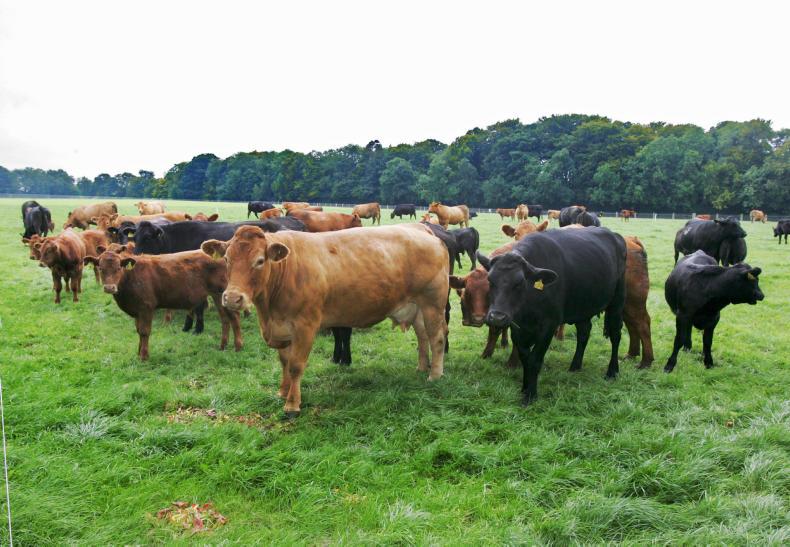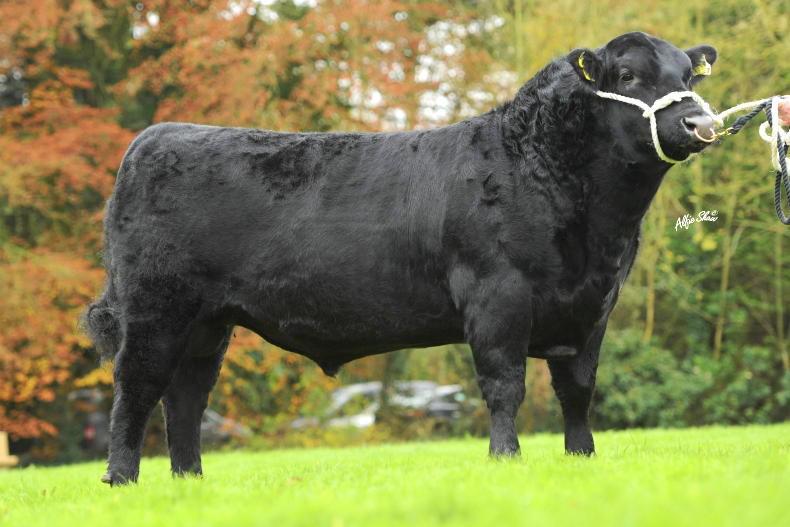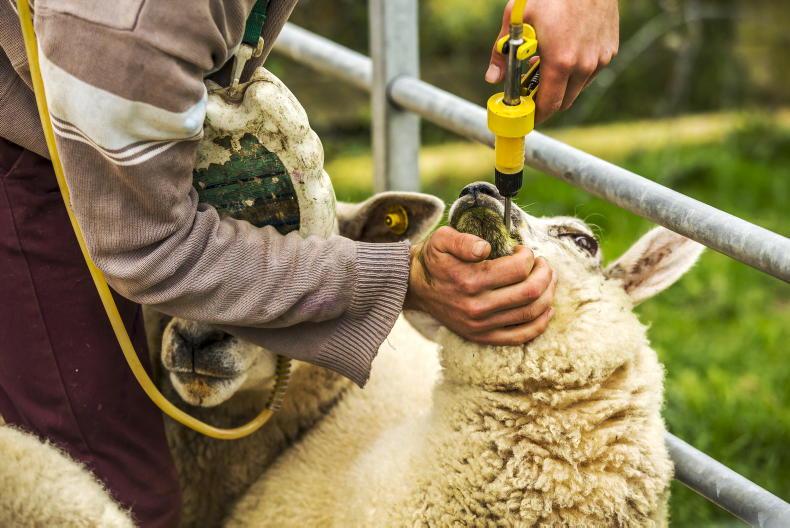Driving stocking rates to 2.42 cow equivalents/ha on a grass-based system delivered a gross margin of £958/ha at CAFRE’s Abbey Farm last year.
Progress and management of the 90-cow suckler herd was outlined by BETTER Farm NI programme adviser Darryl Boyd and assistant farm manager Lindsay Mawhinney, during a virtual farm walk last week.
With the herd having a target GM/ha of £1,162/ha, based on a beef price of 330p/kg, the farm needs to further increase stocking rate to wean and sell 100 cattle per annum.
Herd background
Cow type is predominantly Stabiliser genetics, bred back to Stabiliser sires via natural service and AI.
The current herd is spring-calving, which got under way on 21 February this year. Calving finished 11 weeks later, with 91 live calves on the ground from 90 cows.
Calving interval averaged 365 days for 2020, with previous intervals at 372 days in 2019 and 358 for 2018.
Annual herd targets aim to have 95% of cows mated scanning in-calf from a nine-week breeding season, with 95% of cows confirmed in-calf delivering a live calf on the ground.
Breeding 2020
In order to build numbers to wean 100 calves annually, 90 cows and 24 replacement heifers were bred this summer.
Heifers were weaned at 266kg liveweight last autumn and gained 1.1kg/day during the housing period. Turnout weight was 378kg, with heifers surpassing the 420kg weight target when bred.
The 24 heifers were all home-bred animals and bred to fixed-time AI on 14 May. The same breeding programme has been followed for a number of years using CIDRS.
All management routines were followed as per previous years
However, early pregnancy scanning showed just 10 animals held to first service, with a further four heifers holding to second service.
All remaining heifers have since been running with stock bulls and will be scanned this autumn.
“All management routines were followed as per previous years, with heifers also getting a pre-breeding scan to check they were suitable for breeding.
“The only thing different about this year was the prolonged dry spell in May and June, which did limit grass growth. Cows were buffer-fed high-quality silage to stretch the grazing rotation during this period,” said Lindsay.
Cows
Mature cows are running in three groups of 30. Two groups were also bred to fixed-time AI. The first group consists of the best maternal cows in the herd. The second group is made up of first- and second-calving animals.
To ease the demand on labour, the cows on fixed-time AI were only inseminated once
The final group of cows are late-calving animals and those less suited to producing replacements. They have run with the stock bull this summer.
“To ease the demand on labour, the cows on fixed-time AI were only inseminated once. All repeats were covered by stock bulls, as it is time co-suming heat detecting and bringing in animals daily for insemination,” said Lindsay.
High performance
The use of high-genetic merit sires with AI is coming through in-calf performance, which is excellent.
From birth to weaning at an average age of 200 days, or just shy of seven months, bull calves averaged 320kg, or 1.38kg/day on the cow.
Heifer calves gained 1.13kg/day from birth to weaning, averaging 266kg coming off the cow last October.
In 2018, bull calves gained 1.44kg/day from birth to weaning, with heifers gaining 1.16kg/day. Mature cows had a weaning percentage of 46% of bodyweight in 2018, which fell to 41% in 2019.
However, the 2019 figure is lower as the average cow weight increased by 50kg from the previous year, with more mature animals in the herd.
Weaning
All calves were weaned over seven days using the Quietwean nose flaps. Last autumn, calves were allowed to settle indoors before weaning started, due to early housing because of wet weather.
The previous year, calves were weaned outdoors. Again, nose flaps were used. Cows were removed in groups of three, leaving calves in a familiar environment outdoors.
Grassland
The farm is grazed in rotational paddocks and growth rates are measured weekly.
“Walking the paddocks each week is a great way to know what is happening on farm. We know when to go with fertiliser, when grass is starting to get ahead and when to skip paddocks and take them out for silage,” said Lindsay.
The farm is currently stocked at 2.7 CE/ha on the grazing platform, meaning the farm needs to grow 10t of grass DM/ha/year to meet demand. Last year, the farm grew 11.4t DM/ha/year.
Silage
First-cut silage was harvested in mid-May and yielded 8t/ac fresh weight. Analysis of feed value is top-class.
Dry matter is 42%, with the overall D-value exceptionally high at 78%. Energy is 12.3 ME and protein is 16%.
This silage will be targeted to finishing spring-born bulls and heifers surplus to breeding requirement, limiting concentrate intakes.
Bull finishing
All male-born progeny are finished as bulls at approximately 14.5 months old. Creep-feeders are introduced to bull calves in August at 1kg/day of an 18% blend.
By October, calves are eating 2kg/day. Once housed and weaned, bulls move on to 3kg of a 14% protein, high maize ration for November. Meal feeding is stepped up to 4kg by December, 6kg by February and finally fed 8kg/day from March until slaughter.
Bulls also have access to ad-lib high-quality silage throughout the housing period, which limits concentrate levels to between 1.5t/head and 1.7t/head.
Weight gain
All bulls are weighed monthly from housing. But as they come closer to slaughter weight, weighing is increased to every fortnight.
At an average weaning weight of 320kg last October, bulls had to gain an average of 1.5kg/day to meet the target sale weight of 680kg when slaughtering.
Average carcase weight across 40 bulls slaughtered this year stands at 381kg, with a few animals still to offload.
This means bulls averaged 0.87kg of carcase gain over their lifetime, which is on par with the 0.88kg/day of lifetime carcase gain last year.
Read more
In pictures: quality counts at Ballymote weanling sale
Beef Management: autumn-calving tips, feeding cattle and COVID-19 and marts
Driving stocking rates to 2.42 cow equivalents/ha on a grass-based system delivered a gross margin of £958/ha at CAFRE’s Abbey Farm last year.
Progress and management of the 90-cow suckler herd was outlined by BETTER Farm NI programme adviser Darryl Boyd and assistant farm manager Lindsay Mawhinney, during a virtual farm walk last week.
With the herd having a target GM/ha of £1,162/ha, based on a beef price of 330p/kg, the farm needs to further increase stocking rate to wean and sell 100 cattle per annum.
Herd background
Cow type is predominantly Stabiliser genetics, bred back to Stabiliser sires via natural service and AI.
The current herd is spring-calving, which got under way on 21 February this year. Calving finished 11 weeks later, with 91 live calves on the ground from 90 cows.
Calving interval averaged 365 days for 2020, with previous intervals at 372 days in 2019 and 358 for 2018.
Annual herd targets aim to have 95% of cows mated scanning in-calf from a nine-week breeding season, with 95% of cows confirmed in-calf delivering a live calf on the ground.
Breeding 2020
In order to build numbers to wean 100 calves annually, 90 cows and 24 replacement heifers were bred this summer.
Heifers were weaned at 266kg liveweight last autumn and gained 1.1kg/day during the housing period. Turnout weight was 378kg, with heifers surpassing the 420kg weight target when bred.
The 24 heifers were all home-bred animals and bred to fixed-time AI on 14 May. The same breeding programme has been followed for a number of years using CIDRS.
All management routines were followed as per previous years
However, early pregnancy scanning showed just 10 animals held to first service, with a further four heifers holding to second service.
All remaining heifers have since been running with stock bulls and will be scanned this autumn.
“All management routines were followed as per previous years, with heifers also getting a pre-breeding scan to check they were suitable for breeding.
“The only thing different about this year was the prolonged dry spell in May and June, which did limit grass growth. Cows were buffer-fed high-quality silage to stretch the grazing rotation during this period,” said Lindsay.
Cows
Mature cows are running in three groups of 30. Two groups were also bred to fixed-time AI. The first group consists of the best maternal cows in the herd. The second group is made up of first- and second-calving animals.
To ease the demand on labour, the cows on fixed-time AI were only inseminated once
The final group of cows are late-calving animals and those less suited to producing replacements. They have run with the stock bull this summer.
“To ease the demand on labour, the cows on fixed-time AI were only inseminated once. All repeats were covered by stock bulls, as it is time co-suming heat detecting and bringing in animals daily for insemination,” said Lindsay.
High performance
The use of high-genetic merit sires with AI is coming through in-calf performance, which is excellent.
From birth to weaning at an average age of 200 days, or just shy of seven months, bull calves averaged 320kg, or 1.38kg/day on the cow.
Heifer calves gained 1.13kg/day from birth to weaning, averaging 266kg coming off the cow last October.
In 2018, bull calves gained 1.44kg/day from birth to weaning, with heifers gaining 1.16kg/day. Mature cows had a weaning percentage of 46% of bodyweight in 2018, which fell to 41% in 2019.
However, the 2019 figure is lower as the average cow weight increased by 50kg from the previous year, with more mature animals in the herd.
Weaning
All calves were weaned over seven days using the Quietwean nose flaps. Last autumn, calves were allowed to settle indoors before weaning started, due to early housing because of wet weather.
The previous year, calves were weaned outdoors. Again, nose flaps were used. Cows were removed in groups of three, leaving calves in a familiar environment outdoors.
Grassland
The farm is grazed in rotational paddocks and growth rates are measured weekly.
“Walking the paddocks each week is a great way to know what is happening on farm. We know when to go with fertiliser, when grass is starting to get ahead and when to skip paddocks and take them out for silage,” said Lindsay.
The farm is currently stocked at 2.7 CE/ha on the grazing platform, meaning the farm needs to grow 10t of grass DM/ha/year to meet demand. Last year, the farm grew 11.4t DM/ha/year.
Silage
First-cut silage was harvested in mid-May and yielded 8t/ac fresh weight. Analysis of feed value is top-class.
Dry matter is 42%, with the overall D-value exceptionally high at 78%. Energy is 12.3 ME and protein is 16%.
This silage will be targeted to finishing spring-born bulls and heifers surplus to breeding requirement, limiting concentrate intakes.
Bull finishing
All male-born progeny are finished as bulls at approximately 14.5 months old. Creep-feeders are introduced to bull calves in August at 1kg/day of an 18% blend.
By October, calves are eating 2kg/day. Once housed and weaned, bulls move on to 3kg of a 14% protein, high maize ration for November. Meal feeding is stepped up to 4kg by December, 6kg by February and finally fed 8kg/day from March until slaughter.
Bulls also have access to ad-lib high-quality silage throughout the housing period, which limits concentrate levels to between 1.5t/head and 1.7t/head.
Weight gain
All bulls are weighed monthly from housing. But as they come closer to slaughter weight, weighing is increased to every fortnight.
At an average weaning weight of 320kg last October, bulls had to gain an average of 1.5kg/day to meet the target sale weight of 680kg when slaughtering.
Average carcase weight across 40 bulls slaughtered this year stands at 381kg, with a few animals still to offload.
This means bulls averaged 0.87kg of carcase gain over their lifetime, which is on par with the 0.88kg/day of lifetime carcase gain last year.
Read more
In pictures: quality counts at Ballymote weanling sale
Beef Management: autumn-calving tips, feeding cattle and COVID-19 and marts









SHARING OPTIONS